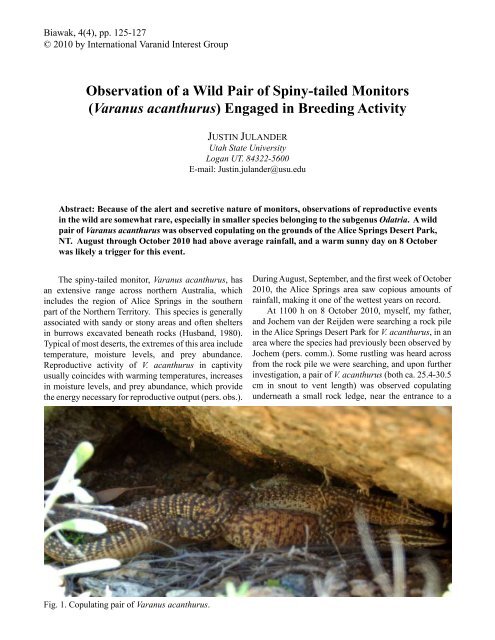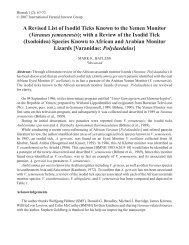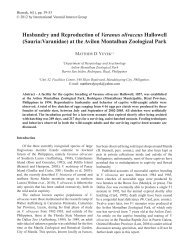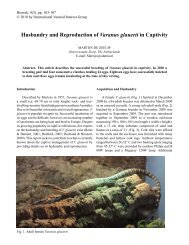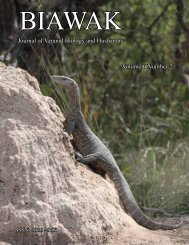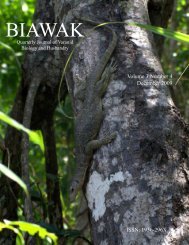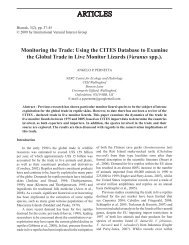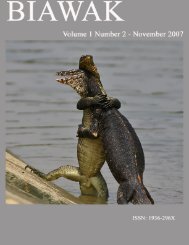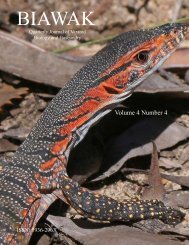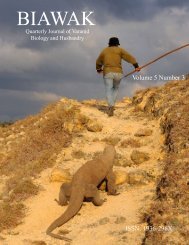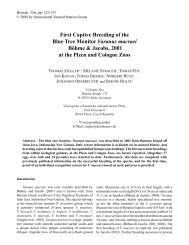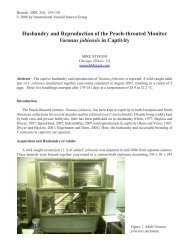BIAWAK - International Varanid Interest Group
BIAWAK - International Varanid Interest Group
BIAWAK - International Varanid Interest Group
- No tags were found...
You also want an ePaper? Increase the reach of your titles
YUMPU automatically turns print PDFs into web optimized ePapers that Google loves.
Biawak, 4(4), pp. 125-127<br />
© 2010 by <strong>International</strong> <strong>Varanid</strong> <strong>Interest</strong> <strong>Group</strong><br />
Observation of a Wild Pair of Spiny-tailed Monitors<br />
(Varanus acanthurus) Engaged in Breeding Activity<br />
JUSTIN JULANDER<br />
Utah State University<br />
Logan UT. 84322-5600<br />
E-mail: Justin.julander@usu.edu<br />
Abstract: Because of the alert and secretive nature of monitors, observations of reproductive events<br />
in the wild are somewhat rare, especially in smaller species belonging to the subgenus Odatria. A wild<br />
pair of Varanus acanthurus was observed copulating on the grounds of the Alice Springs Desert Park,<br />
NT. August through October 2010 had above average rainfall, and a warm sunny day on 8 October<br />
was likely a trigger for this event.<br />
The spiny-tailed monitor, Varanus acanthurus, has<br />
an extensive range across northern Australia, which<br />
includes the region of Alice Springs in the southern<br />
part of the Northern Territory. This species is generally<br />
associated with sandy or stony areas and often shelters<br />
in burrows excavated beneath rocks (Husband, 1980).<br />
Typical of most deserts, the extremes of this area include<br />
temperature, moisture levels, and prey abundance.<br />
Reproductive activity of V. acanthurus in captivity<br />
usually coincides with warming temperatures, increases<br />
in moisture levels, and prey abundance, which provide<br />
the energy necessary for reproductive output (pers. obs.).<br />
During August, September, and the first week of October<br />
2010, the Alice Springs area saw copious amounts of<br />
rainfall, making it one of the wettest years on record.<br />
At 1100 h on 8 October 2010, myself, my father,<br />
and Jochem van der Reijden were searching a rock pile<br />
in the Alice Springs Desert Park for V. acanthurus, in an<br />
area where the species had previously been observed by<br />
Jochem (pers. comm.). Some rustling was heard across<br />
from the rock pile we were searching, and upon further<br />
investigation, a pair of V. acanthurus (both ca. 25.4-30.5<br />
cm in snout to vent length) was observed copulating<br />
underneath a small rock ledge, near the entrance to a<br />
Fig. 1. Copulating pair of Varanus acanthurus.


